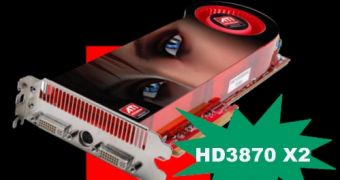Advanced Micro Devices has offered a sneak preview of its next-generation video cards featuring the R680 graphics core. The company was pretty reluctant with giving additional details about the product and what stunned the press most was the fact that they won't allow anyone to take pictures of its PCB side.
Instead of using a single 80-nanometer graphics monolithic processor, AMD mixed two 55-nanometer processor cores. The AMD officials refused to confirm the fact that the R680 GPU is is comprised of two RV670 GPU cores on the same board, although they managed to confirm that each RV680 core shares the same technical specifications with the "younger" RV670.
The RV670 has been announced back in November, when the chip manufacturer officially unveiled the Spider platform, comprised of the Phenom processor and the RV670 55nm desktop graphics adapter. The company does not intend to market the video card as a high-end product, although the IT industry rates it as one of the best products to have seen daylight during 2007.
AMD also talked about the RV620 and RV635 GPU cores, a 55-nanometer version of the older RV610 and RV630 processors, respectively, but the presentation's "guest star" was the R680-based video card.
I have previously told you about the fact that the dual-GPU approach has been successfully used by other video card manufacturers in order to achieve highly performing adapters. For instance, the Voodoo 5 family manufactured by 3dfx was powered by multiple processors. ASUS, Gigabyte, Sapphire, HIS and PowerColor also introduced their dual-GPU video cards, although the GPU manufacturers never encouraged this practice.
Although the AMD officials kept the participants in the dark with the actual technical specifications of the video card, it is assumed that it can compete with a cluster of 1000 Cray-1 supercomputers (rumor has it that it can reach a computing performance of 250 Gigaflops). It is scheduled for release in the first quarter of the year, but I bet the price will be as "substantial" as it's performance (measured in giga-dollars, of course).

 14 DAY TRIAL //
14 DAY TRIAL //